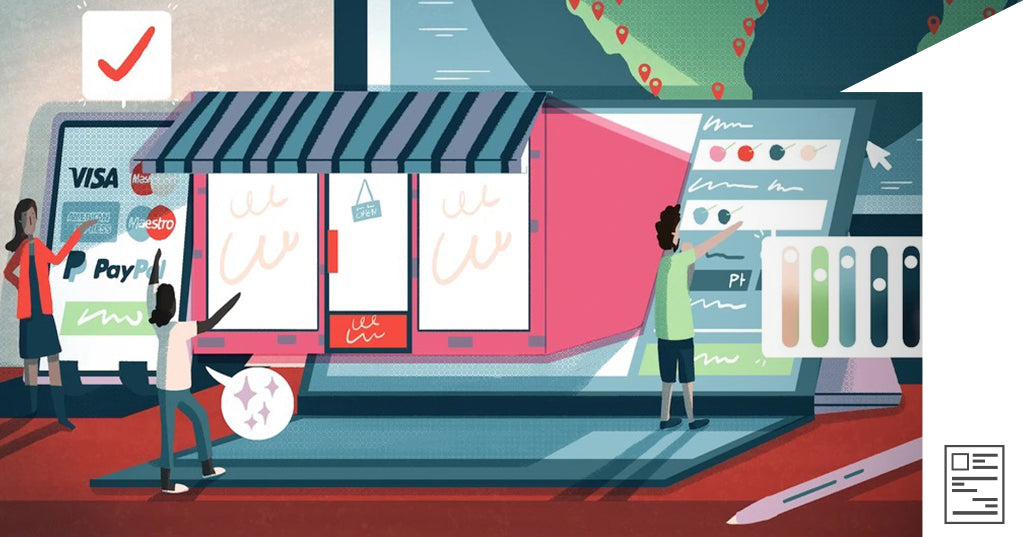The path to entrepreneurship has many routes. Not everyone you see with a successful online business just quit their nine-to-five job one day and became profitable the next.
Some of us like to test the waters first. Maybe you know you want to start a new business but you’re not exactly sure what it should be. That’s where starting a part-time business, or a weekend business, comes into play. It’s a low-risk way to experiment with different ideas while you have a full-time salary.
But turning an online business idea into reality on the side isn’t easy. You come home after a long day of work, you spend the little time you have with your family and friends, and you try to jam in a productive session, working on your side hustle before going to bed.
It takes a little mental sweat, but it’s 100% doable. This article will walk you through nine profitable part-time business ideas you can start today, with a guide for planning your weekends so you can make the most of your spare time.
9 best part time business ideas to run in your spare time
With a little know-how and hard work, you can start your own part-time business that makes more money than driving for Uber or babysitting. Check out the following nine ideas you can take advantage of to become your own boss today:
- Dropshipping
- Print on demand
- Make and sell crafts
- Sell or refurbish furniture
- Create non-fungible tokens (NFTs)
- Go freelance
- Start a pet business
- Become a live streamer
- Become an affiliate marketer
Dropshipping
Whether you want some extra income or want to grow an online store, a dropshipping startup is the best business idea for you. Dropshipping is a fulfillment method where you don’t keep any products you sell in stock. Instead, you purchase the items from a supplier after the order is placed and the supplier ships it to your customer.

Most dropshipping stores don’t take a lot of money or time to set up and run. When done correctly, it can be a profitable business venture for you.
Most people don’t quit their day jobs right after launching a dropshipping store. They spend time ramping up their store first, working out the customer service kinks and finding the best suppliers, until they see a healthy cash flow. All businesses and entrepreneurs are different, but it’s possible to generate an income of $1,000 to $2,000 per month after a year of working on your store approximately 10 to 15 hours per week.
While it may seem challenging at first, this passive income idea can earn you residual income and eventually a full-time salary when done right.
Resources:
- How to Start a Dropshipping Business: A Complete Playbook for 2021
- Make Dropshipping a Success: Tips and Stories to Inspire Your Dropshipping Venture
Print on demand
Print on demand is an easy way to monetize your creativity. It involves working with a supplier to customize products like tote bags or t-shirts with your own designs. The supplier sells them to you on a per-order basis with your brand. In other words, you don’t pay for any products until you’ve sold them. The company also fulfills and ships your customers’ orders.
Print on demand makes a great part-time business idea because it takes little to no investment. You don’t hold any inventory. You don’t have to spend money on materials or equipment. You just need to choose a print-on-demand company to work with, create your design, then upload them to a Shopify store.
The biggest investment you’ll make is time for creating your designs and building your online brand.
Popular print-on-demand products business sell include:
- T-shirts
- Books
- Bags
- Wall art
- Phone cases
- Mugs
- Socks
Interested in starting a print-on-demand side business? Check out A Canvas for Creativity: Here Are 10 Print-On-Demand Products You Can Sell (Without Holding Inventory).
Make and sell crafts
This is the most obvious part-time business idea for most full-time workers. Anyone can make and sell crafts from home today with the rise of ecommerce. Plus, working with your hands is good for your brain.
Experts found that using your hands on a task that doesn’t take much thinking gives your brain a chance to relax and rest. It also can give you a sense of accomplishment and reduce stress and anxiety. Think of it as a meditative practice, but one that turns a profit later down the line.
Some business ideas are:
- Starting a jewelry line
- Upcycling vintage clothing
- Starting a candle business
- Creating ceramic pots for plants
Your first thought may be to sell your crafts on sites like Etsy or eBay, and that’s not a bad idea. Yet you could also build a website and start your own business online. It’ll save you a ton of money on commission fees that marketplaces take from your sales and help you build a successful business online.
Your options are endless. Need help finding your creative calling? Take the “What type of craft should I make and sell?” quiz in our article Craft Your Own Future: 10 DIY Business Ideas You Can Start From Home.
Sell or refurbish furniture
Got a knack for working with your hands but crafts don’t spark your creativity? Try selling or refurbishing furniture online.
Woodworker Chris Hughes, founder of Timberware, worked as a welder’s apprentice and general contractor before starting his furniture business. Being a handyman and building homes drove him to love working with wood and creating custom furniture for clients.
There are different ways to start a furniture business on the side:
- Maker: someone who builds furniture by hand.
- Designer: someone who designs furniture and has a manufacturer build it.
- Reseller: someone curates pieces and sells a number of items from different brands.
- Dropshipper: someone who works with a supplier to fulfill and ship orders.
Convinced that selling furniture is your future side business? Learn the ins and outs of starting by reading How to Sell Furniture and Home Decor Online: The Ultimate Guide.
Create non-fungible tokens (NFTs)
Maybe you’ve heard of artist Grimes selling NFTs for millions of dollars, or how billionaire entrepreneur Mark Cuban is betting big on them. Maybe you haven’t. But if you’re a creator, creating non-fungible tokens, or NFTs, can be a great side business to start online.
NFTs are unique pieces of art minted on a cryptocurrency blockchain, or a secure ledger that records transactions for digital assets. Think of NFTs like trading cards. People can buy your NFTs in a marketplace, then sell or trade them for a higher price in the future.
NFTs can be anything from photos, videos, audio, or other types of digital files. The NFT community is also growing fast, with people from around the world coming together to learn, create, and build together online. You can even build galleries to show off your work in the metaverse.

@reylarsdam, a digital creator, explains, “NFTs, to me, are a way to reinvent oneself. It’s a new world of opportunity. My advice for anyone looking to get involved would be becoming part of the community. The NFT community is the backbone of any successful venture in the NFT space.”
Go freelance
Many full-time business owners selling services online start part-time freelancing. Freelance means you work with different companies at different times rather than being employed by just one. It’s a popular part-time business idea because it doesn’t take any money to start. You only need a skill to sell.
Many full-time employees turn their passions into a part-time business. For example, Marketing Director of Long Island Screen Printing Kaitlin Cremmins sells her photography services to businesses in Long Island, New York.
“I’ve always loved photography, but I could never define an exact niche,” Kaitlin says. “I love to shoot many different things, like maternity shoots, real estate tours, concerts, product shoots for local businesses. Because I work a full-time job, I can shoot photos on the weekends and on holiday breaks. It’s where my creativity shines and is something I am really passionate about. Plus, I can make a little bit of extra money.”
Freelancing comes in many forms:
- Virtual assistant
- Freelance writing
- Photographer
- Graphic designer
- Real estate agent
- SEO consultant
- Copywriter
- Blogger
The best part? You can start a home-based business freelancing from anywhere. Freelancers like Rachael Pilcher, founder of Taco and Bean, a digital nomad lifestyle blog, says, “I worked in corporate law for 10 years. Breaking away from the rubbish like office politics and team gatherings was bliss. I also love the challenge of the nomadic lifestyle and seeing different places around the world.”
Freelancing is one of the higher growth industries for both part-timers and full-timers. It’s projected that by 2027, 86.5 million people will be freelancing in the United States, making up 50.9% of the total workforce. Many freelancers also go on to diversify their income streams by creating online courses or selling digital products online.
You could sign up for a freelance website like Fiverr or Upwork. But they cut into your earnings by taking commission fees for letting you use their websites. Instead, get your own domain name and start an online portfolio. You can scan job boards and pitch to different companies, or market yourself on social media sites like Twitter or LinkedIn.
Does having a part-time gig sound interesting to you? Read Ryan Robinson’s guide to starting a freelance business on the side to learn step-by-step how to start your own.
Start a pet business
The pet industry is one of the most lucrative business opportunities for part-time entrepreneurs. It’s pandemic-proof and has shown significant growth in recent years. People are also jumping on the pet parenting trend, where owners treat their pets like family and buy them products like beds, sweaters, and raw food.
Globally, the pet care market has grown from $216 billion in 2020 to $232 billion in 2021, a 6.1% compounded annual growth rate. If you’re looking to break into the pet industry, pet food and treats make up the majority of ecommerce sales.
Even if you’re not into cooking up dog treats, you can also get into:
- Pet care services like dog walking and grooming
- Pet supplies like food dispensers
- Pet products like personalized mugs or shirt
Let the Dog Out (LTDO) is a dog-walking service based in Guelph, Ontario. LTDO offers free meet-and-greet sessions to let dogs meet their new sitter (you) and get comfortable with them.

A service-based pet business is built on personal relationships. So if you like dogs and (kind of) like people, it can be a good part-time small-business idea for you. You just need your own website to start. If your services are good, you may get new clients through word-of-mouth referrals and can grow your side business into something more full-time.
Become a livestreamer
Streaming is becoming a popular way to entertain people. A professional streamer is someone who makes money from live broadcasting games, music, art, live content, and more. Livestreaming used to be just for gamers, but there’s been a rise in IRL streamers and “just chatting” streamers, which are people who just broadcast themselves talking to their viewers.
Streamers make money through donations, advertisements, subscriptions, and sponsorships. If you’re using a streaming service like Twitch, viewers can donate money in the form of “bits,” which are worth $.01, on average.
There are many categories of livestreaming, from people live streaming their painting to personal trainers streaming classes, and more:
- Just chatting
- Music and performing arts
- Talk shows and podcasts
- Travel and outdoors
- Food and drink
- Makers and crafting
- Sports and fitness
Livestreaming as a side business takes little investment. You can start with just your phone and a tripod, which you can get for $20 on Amazon. As you can see, there are plenty of options for what you can stream and make money from. Choose your niche, then sign up for a platform like Twitch or Livestream to start streaming today.
Become an affiliate marketer
Affiliate marketing refers to earning a commission by promoting a product or service made by another company. It’s a business model where you, the affiliate partner, earns money for providing a specific result to the company or advertiser. Most of the time it’s a sale, but other programs give payouts for leads, click, downloads, and other business outcomes.
Affiliate programs are typically free to join, so startup costs are low. Because it’s a performance-based opportunity, you can turn this from a part-time business idea into a venture that provides residual income.
The list of affiliate marketing niches is long. You can find products to sell in any category including:
- Hobby: photography, travel, and casino.
- Money: bitcoin, investing, and credit cards.
- Health and wellness: weight loss, fitness, yoga, nutrition.
- Lifestyle: fashion, jewelry, online dating.
- Home: coffee, baby products, dogs, plants.
- Tech: web hosting, WordPress, gaming, VPN.
The way affiliate programs work is pretty straightforward. You mention a product by sharing it through your social media, blogging website, YouTube channel, podcast, etc. Then you earn a commission each time someone makes a purchase through your unique link.

Affiliate marketing is easy to execute, meaning you just need to market a product versus creating one. It’s low risk because it’s free to join a program. And it’s easy to scale, because once you build an audience and create your content, you make money without having to do much manual work.
Making the most of the weekends to grow your side business
Your weekends allow you to get much more done in much larger chunks. They’re usually where you’re most capable of growing your business or having the most impact on your business when you’re working a day job.
However, are you making the most of your weekends? How often do you find yourself distracted or making excuses when you’re not getting enough done? How should you structure your weekends? What does a weekend, optimized for productivity and growing a business, look like?
I’m going to answer these questions and share what has worked, and continues to work, for me. Additionally, I’m going to share my action plan, exactly how I structure my weekends, and what I do every weekend that has helped me grow my side business and maintain a great work/work balance.
Switch up your mindset
The first thing you need to consider is how you think of your weekends.
What you do during the week should set you up to get more done on the weekend. Don’t use your weekends to support the stuff you do during the week. Instead, whenever you come home from your day job and begin working on your business, make sure it supports what you plan to do over your weekend.
For example, if you’re planning to tackle your website’s design over the weekend, then choose templates, design logos, draw layout ideas, and write copy throughout the week. That way, when the weekend rolls around, you can focus on the most important task: getting the website up.
Make weekdays support your weekend
Whenever you think up a task or project but can’t make time for it during the week, David Allen, author of Getting Things Done, suggests you add it to a “next actions” list instead of a “to do” list. Throwing items into a to-do list is non-actionable. If you set an ordered list of the next things you need to do for your business, it will require and encourage you to make quick decisions.
Think up a great, actionable idea for your business? Put it in your next actions list. Come up with a new marketing idea that will take several hours to implement? Put it in your next actions list.

At the end of the week, organize these ideas, tasks, and projects into time slots throughout your weekends, then pull each task from your next actions list and move it into your calendar for the weekend. (More on this in the next section.)
Now let’s get into what a typical weekend looks like for me and how you should consider structuring yours to get more done.
Structure your weekend
Friday
While you won’t have as much time on Friday to get as much done as you can on Saturday or Sunday, it’s a good time to reflect on what you’ve accomplished throughout the week and what you plan to do over your weekend
Reflect
It’s good to sit down for five minutes, before planning out your weekend, to reinforce what has (or hasn’t) been working for you.
Not taking the time to see where you went right and wrong can stunt your growth as an entrepreneur. Your business only grows when you do. Here are some questions you can ask yourself:
- What were my top wins this past week?
- What didn’t I get done?
- Where did I waste time this past week?
- What was the best part of my week?
You can answer these questions out loud or write them down in a journal or private document (like Google Docs or Evernote).
Plan of attack
Now it’s time to schedule your weekend. Set blocks of time for each task and get your priorities in check.
Your weekend should be flexible. Things happen and you can’t always stick to your schedule. However, don’t use that as an excuse to procrastinate. Stay flexible for when “life” happens, but don’t stay flexible just because Game of Thrones or your favorite TV show might be on.
Before planning out your weekend, ask yourself a few questions to get a better perspective on what needs to get done:
- What must I get done no matter what this weekend?
- Are there any potential distractions or commitments this weekend that I will need to account for?
Now it’s time to plan your weekend for success.
First, if you don’t know what you should be doing, use the Pareto principle. Look at the 20% of things you’ve been doing for your business that have yielded 80% of your results.
Next, use a tool like Trello or even Google Calendar to set your schedule for the next two days. Pull the tasks you put off from your next actions list and start to schedule them into your weekend. If the task can be done in five minutes or less, do it immediately (yes, while you’re still scheduling your tasks) instead of putting it off for the weekend.
In the next section, I’ll talk about what your Saturday and Sunday might look like to help you figure out how to make the most of your weekend.
Here’s an example of what my Trello board “Weekly to do” looks like:

Generally, you’ll want to tackle the most difficult or time-consuming tasks first. If you don’t think you’ll be able to complete all your tasks for the day, do the most important things first. The most important task is up to your discretion, but generally, if it has a looming deadline or will make the most immediate impact on your business, it’s the most important task.
Saturday
Let’s carry over that excitement and momentum from Friday’s reflection and planning and begin tackling the most important tasks on Saturday.
“Airplane mode” Saturdays
So, because you hopefully have scheduled the most important or difficult task first, that’s where you’ll be spending most of your Saturday. It’s also likely to be your most time-consuming task, which is why it’s also important to get it out of the way as quickly as possible.
The key to getting more done on the weekends is focus. Sounds simple, right?
On paper, sure, but in reality, there are a lot of things to keep you distracted.
My Saturdays are usually the most productive day of my weekends. I like to put myself into “airplane mode.” Much like how your phone’s Airplane Mode disables all of your phone’s connectivity to the internet, I do the same thing by cutting myself off from distractions.
Though it’s unlikely you’ll be able to get much done without the internet, there are tools you can use to help keep you from wandering off and browsing Facebook, while staying connected to the web.
These are the Chrome extensions I use to put myself in airplane mode every Saturday.
- StayFocused: Block out the sites that steal your time so you can work on what matters.
- RescueTime: Track all your time on the web to later review where you waste the most time.
- Pomodoro Timer: If you’re not familiar with the Pomodoro Technique, it helps you work in small intervals of 25 minutes of getting stuff done and a short five- or 10-minute break. Instead of plowing through without stopping, Simple Pomodoro is a timer that will alert you when it’s time to take a break—and when it’s time to get back to work.
Sunday
I don’t like to lose the momentum I created on Friday and Saturday, however, even I understand that there are errands and things that need to be done on the weekend. That’s what Sunday’s for.
If I have time on Sunday, I will finish any other tasks, but if I can’t, I will add them back to my next actions list or simply schedule them for next weekend.
Schedule content for the week
Spend some time automating whatever you can for the following week. For example, every Sunday evening, I use Buffer to schedule all my social media posts until the following Sunday.
You can do this as well. Spend your Sunday evenings briefly scheduling out social media posts, planning out blog content, or scheduling emails to be sent to your email list.
Plan your week ahead
I use Trello (you can use any scheduling tool you feel comfortable with) to plan out the week ahead. This way, I know exactly what I should (and need to) be working on when I get home from work. I’m not wasting time deciding what to do or trying to figure out what to do next. I just come home and take action.
Set goals
If you don’t already, I strongly suggest writing down and tracking weekly goals for yourself and your business. Some example goals you can set are:
- I will easily launch my new ecommerce website by Saturday this week.
- I will easily go to the gym at least three times this week.
- I will easily get 10 sales to my store by Saturday this week.
- I will easily double my store’s weekly traffic, from 100 visitors to 200 visitors, by Saturday this week.
Writing your goals down helps keep you accountable and brings you clarity. How do you really know what you want to accomplish in life and in your business if you’re not tracking it?
Prime yourself for the week ahead
Stop dreading Mondays every Sunday night. Set the tone for an amazing week. Look forward to getting up early, tackling your morning routine, and getting home after your nine-to-five to work on your side business. Make your Sunday nights amazing!
Watch a few motivational videos on YouTube or an inspiring TED Talk, read a Shopify success story, or learn something new before going to bed. You don’t have to over-stimulate yourself, just put yourself in the right mindset before going to bed.
What’s your next great business idea going to be?
Now it’s just a matter of repeating this process and becoming really good at adapting it. You won’t be perfect and won’t always have the most productive weekends—I know I don’t.
However, making an effort to work at it every weekend and putting in that work, even when it’s only for a few hours, can make all the difference. All of those efforts begin to add up over time and, before you know it, you can have a full-time ecommerce empire on your hands.
What do you think? How do you, as a sidepreneur, manage to build your ecommerce empire on the side while working a nine-to-five? How will you make this upcoming weekend much more productive? Let me know in the comments below. I engage and respond with everyone.
Start Your Journey













